President's Message
I hope this message finds all of yu well. We are very sorry to have cancelled the last meeting of this year. The December meeting is always a festive occasion. The Boehling family provides wonderful holiday decorating and treats. We look forward to a better year with more wonderful treats.
Our work continues. Inquiries sometimes lead to rediscovery, new discovery, and even at times "treasures" to add to our collection. As previously metioned, our cemetery committee is always at work and on the move. We recently received an inquiry about information on a cemetery located in eastern Henrico on Battlefield Park Road. The cemetery is listed in the "Henrico County Cemeteries" book as the Harris-Lawrence-Jackson Cemetery. However, upon inspection by John Shuck, at least one of the graves had not been recorded. Additional research and planning for clean-up restoration is underway.Another inquiry led to the rediscovery of historical information regarding the school house at 2317 Harvie Road. The school is located west of Gospel Baptist Church on the church property. It is listed as 043-0187 in the Virginia Department of Historic Resources archive survey files. It is also in the "Inventory of Early Architecture and Historic Sites" County of Henrico, Virginia, 1976 and the guide book "Inventory of Early Architecture" County of Henrico, Virginia, referred to as Schoolhouse (Mechanicsville Pike). The school house is the first known public school in this area, established in 1876, when an acre of land was deeded to the Board of School Trustees. This is the original brick structure that was called the "Mechanicsville School" before the Glen Lea School was built closer to the city. The building was originally a one room plan building and later extended by the church. Many thanks to Mary Ann Soldano for providing this information.
The latest "treasure" added to our collection is a 1903 advertising calendar manufactured by Cusson's, Mary & Co., Glen Allen, Virginia donated by Carl Sparks of Payson, Arizona. It was found in his parents' possessions. The acquisition may inspire some to research the interesting life of Capt. John Cussons and the printing company he founded. The company productions included the weekly newspaper publication of "The Idle Hour." Their productions also included wine bottle labels. A booklet, dated 1898 found at an online auctioin site included the following: "Our motto-Prompt service and direct trade".
More to come later, including research papers donated by R. F. Helm on the history of the shores of the James River including possible recent discoveries. Stay tuned.
Lastly: sometimes, without awareness, we live wiht history among us. Did you ever wonder about the pitcher that belonged to Aunt Martha in your possession? Henrico Curator Bryce Stanley presents a very entertaining, humorous video, featuring tips on researching items that can be viewed on YouTue - just Google "Quarantined With A Curator."
We give thanks for our many blessings. May you and your family have a woderful holiday season.
Sarah Pace
President
>Back to Top<
Here's Our Holiday Gift
Under current conditions resulting from the coronavirus, the society has been unable to meet. For a while, we thought that Facebook posts of past articles would provide a nice stopgap measure to substitute for our newsletter. Those articles are still on our Facebook page, but we thought it was time to get out a regular volume, and what better time of the year to bring out this gift. We hope you enjoy it and hope to be back to regular publication in the new year.
And in the spirit of giving, you can help us out by renewing your membership.
>Back to Top<
Time to Renew Your Dues
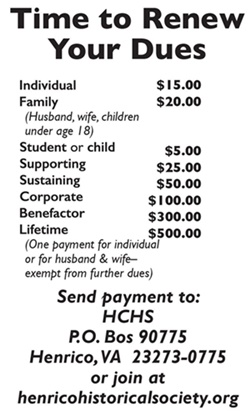
>Back to Top<
Reclamation Efforts at Anderson Cemetery
Deloris "Ann" Lawson, President of the Anderson Cemetery League, wrote us about the organization's efforts in its reclmation project. Here's what she had to say:
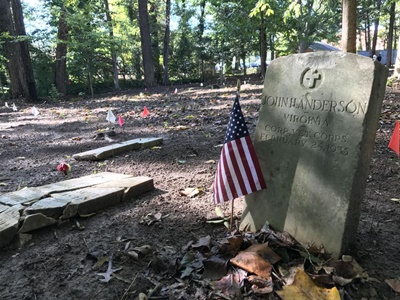
In 2015, the Historical Ministry decided to have as one of our goals to reclaim, preserve, and embrace the history of Mount Olive Baptist Church. Anderson Cemetery was one of the projects that we decided to reclaim. After much research, we discovered that Anderson cemetery was previously referred to as the "colored Burial Ground" in an 1886 deed. According to historical documents and previous research, a deed from 1867 refers to another property on the south side of the "two-acre lot that has been sold for a colored Burial Ground." A recorded deed for this sale has not been found.
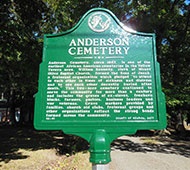
We have uncovered a stone-enclosed Anderson family plot and can provide names of other Andersons who are buried in Anderson Cemetery. Over the years, the name of the cemetery changed from the Graveyard League in 1905 and 1935, to Anderson Graveyard League or Anderson Cemetery League in deeds from 1938 and 1952. According to oral research, Anderson cemetery got its name from James Anderson, the grandfather of Lloyd Jackson, and the great grandfather of Charles Anderson, who formed the Anderson Cemetery League. The last burial occurred in 1991.
We have cleared most of the cemetery and have found more than 75 gravesites, including World War I and Korean War veterans and early African American community leaders, and made them accessible online.
>Back to Top<
Inventive Henricoans
Our Newsletter of 19 June 2019 featured a calendar patented by John Cussons. Now, the society possesses a calendar he produced, so it seems appropriate to feature another of his patented calendars. Cussons provided a long description of how to use it, but the illustrations he provided for the patent seem self-explanatory, so only his introduction is reproduced here.
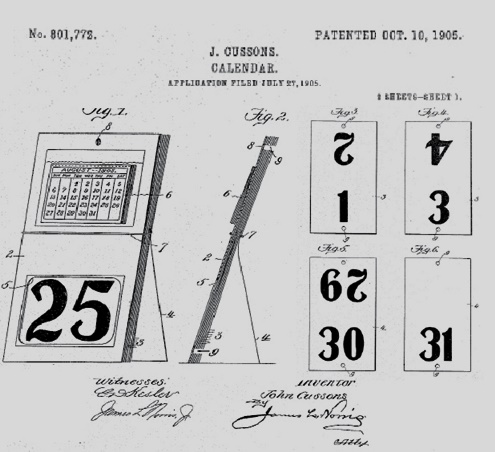
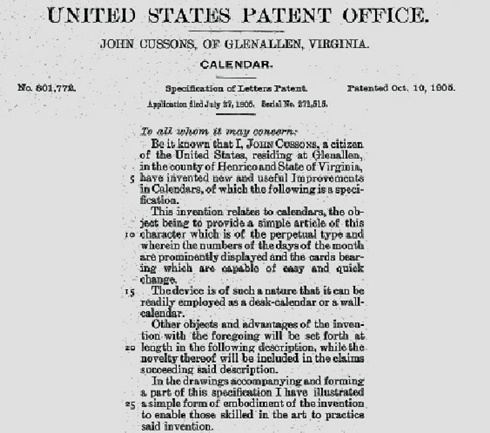
>Back to Top<
Gushers That Didn't
Dreams of wealth at a dollar a share are crushed by ... Gushers that didn't
Lately, I can't get the "Beverly Hillibillies" theme song out of my head - particularly the line, "When up from the ground come a bubblin' crude." That bubbling "black gold" brought Jed Clampett millions; and a little over a century ago, different but related bubbline led some people to suggest the possibility of similar wealth to local investors in a gas and oil drilling enterprise.
It all began in 1916, in our neighboring sister county of Chesterfield when the 15 June Times-Dispatch ran an article headlined "Develop Natural Gas Beneath River's Bed." It announced the Virginia Gas and Oil Corporation's plan to begin drilling on Purdue Island in the James River about 16 miles south of Richmond. The item noted that water men had long been aware of gas bubbling up in continuous streams at low tide in the old channel of the river that was abandoned during the Civil War when Dutch Gap was cut. On the previous day, men had collected some of the gas and burned it in a "regular gas mantle;" and the conditions in the area convinced C. A. Owens, the company's general manager, that there was a 5-mile by 2-mile pool of petroleum between two and three thousand feet down. The article went on to say that another operation, Tidewater Oil and Gas Corporation, had been organized to locate wells in the area.
Two weeks later on 2 July 1916, Tidewater Oil and Gas took out a half-page ad in the Times-Dispatch with the headline "Millions in Oil and Gas" superimposed on a cloud of oil gushing from a huge derrick and touting the existence of "enormous quantities of oil and gas" evidenced by the local sandstone formations, proximity to coal mines and the gas seepage. Offering stock in the concern for a dollar a share, the ad included a small coupon at the bottom that could be mailed back to the company's office at 11 North Eighth Street in Richmond.
That initial offer probably did not inspire great confidence in the company's attention to detail; because two days later, Tidewater had to take out another ad to correct the coupon's offer. The tiny print in the coupon had offered the stock at $100 per share, while the original ad had featured a large bold $1 price per share. The new ad also contained a revised coupon.
Each Sunday thereafter, the Times-Dispatch carried an ad for the drilling operation claiming sales "beyond expectations" and that if the company developed large gas fields, Richmond would be the "Largest Manufacturing City in the South."
As we know, this never happened, and gas fields and oil derricks do not fill the local landscape today. Investors who were not dissuaded by the $100 mistake in the first ad probably should have been concerned by the three-quarter page ad in the 2 August 1916 Times-Dispatch. Claiming a "Gibraltar of Actual Evidence" for the presence of gas and oil, it announced in what appears to be at least 100-point all caps that "TIDEWATER WILL BE THE FIRST IN THE / FILLD [sic] WITH OIL DRILLING MACHINERY." The company's proofreading errors seem to be harbingers of the ultimate failure of the hoped-for bonanza.
Nevertheless, the ads continued; and in an ad on 20 August 1916, the first mention of possible Henrico operations appeared. It reprinted a letter from Thomas G. Sydney of Sydnor Pump and Well Company announcing that their drilling machinery would be on the Purdue Island site in two days and that he and "other stockholders in our Company are personally and largely interested in Varina Plantation, which is in close proximity to your property."
Ensuing ads seemed to be generally smaller, chronicling drilling depths reached, stockholder meetings and changes in company directorate; but it would be months before the oil search reached Henrico County. That happened on 1 July 1917, when Tidewater Oil and Gas ran an ad anouncing "The Greatest Discovery Ever Made in Virginia." Like many of the earlier advertisements, it contained a letter, this one from J.E. Blackburn, the manager of the well, to R.E. Craig, President of Tidewater Oil and Gas. Blackburn is identified as "a man that has devoted more than twenty-three years of his life in the OIL DEVELOPING BUSINESS" who sent the letter direct from "the well in Henrico, near Meadow Station" which had reached a depth of 980 feet. Blackburn indicated that he encountered "SARATOGA SANDS in three stratas [sic]," which in his experience made "the chances about 98% in favor of success to 2% against success." Blackburn even adds that "I would advise my mother to buy YOUR TREASURY STOCK." When the ad goes on to claim "THE METHODS OF THE COMPANY HAVE BEEN AND ARE ABOVE REPROACH" and that "THE METHODS OF THE COMPANY HAVE BEEN AND ARE ABOVE REPROACH" and that "THE BOARD OF DIRECTORS ARE HEADED BY THE BEST MEN OF RICHMOND, BOTH MORALLY AND FINANCIALLY," it all seems that "The lady doth protest too much, methinks."
It seems as if finding oil in Henrico had been seen as a possibility, however quixotic, for a while before this; and while it did not seem to be an idea that regularly surfaced in local papers, it did appear several times in Alexandria for some reason. The 2 November 1915 edition of the Alexandria Gazette ran a brief article headlined "Oil in Henrico" which said, "Henrico county is looming large as a prospective oil center" and that there was the "possibility of Fairfield District becoming a great petroleum field." The possibility was suggested by oil that had "seeped up through the surface on Henrico lands." Then about two weeks later, the 15 November edition claimed that "Prospects for oil being obtained in commercial quantities from Henrico oil lands are excellent" according to the state geologist and went on to say that F.M. Novell would record in the Henrico County Circuit Court options on 2,000 acres of land for a company he headed. The, however, never seemed to happen. Also unverified is the paper's claim on 24 April 1916, that contracts had been awarded by the Mutual Oil and Gas Corporation for boring a pair of wells on its property in Henrico.
There was certainly the possiblity of oil being found in the area since it lies on a pointed oval geological formation running north to south thousands of feet underground called the Richmond Basin. Its eastern edge is near the Swift Creek Reservoir, its northern point at I-64, spanning the James River with the southern point at the Appomattox River. That rift basin had accounted for the area's early coal mining enterprises. In fact, "Oil Resources in Virginia" at virginiaplaces.org points out that 38 exploratory wells were drilled in the basin between 1897 and 1985. One of those was the 1917 well drilled by Tidewater Gas and Oil in Henrico County. Gerald P. Wilkes notes in "Geology and Mineral Resources of the Farmville Triassic Basin, Virginia" that the well was in the Fork Swamp area and went down 1,518 feet and had a show of gas and oil at 938 feet. That well was identified as Johr 1 by John C Maher in "Geologic Framwork and Petroleum Potential of the Atlantic Coastal Plain and Continental Shelf." so named, it seems, because it was on land owned by the Johr family. Maher listed its location at approximately 37 30' N and 77 15'W.
Those coordinates indicated a spot south of Old Williamsburg Road just east of Elko Road, and it meant a pleasant drive to the area. It's a narrow little road and the well appears to have been located in what is now a large, vacant wooded area. The overgrowth hides any evidence of the well's existence from the road just as time seems to have covered over the memory of Tidewater Oil and Gas, which finally failed in 1921, taking with its investors' dreams of the potential wealth like that which brought Jed Clampett a life with "swimmin' pools, movie stars."
Joey Boehling
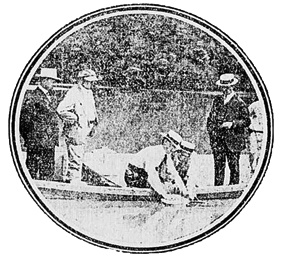
Testing the waters. Representatives of the Virginia Gas and Oil Corporation gather gas seeping from the James River near Purdue Island for testing prior to potential gas and oil drilling operations.
Below - Johr I well location. The inset on this 1916 map of Henrico shows the Johr land, the location of the Tidewater Oil and Gas Corp's well.
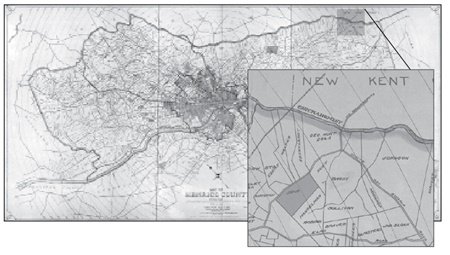
Selling the dream. Ads from the Times-Dispatch promote the stock offering in Tidewater Oil and Gas Corporation's oil drilling plans. At the far left is the first ad the company ran and the coupon at the bottom lists the incorrect share price. The above ad is the first announcement of the corporation's plans for operation in Henrico County. The small item is a segment of the huge three-quarter-page ad that carried the misspelling that could have been a sign of future problems.
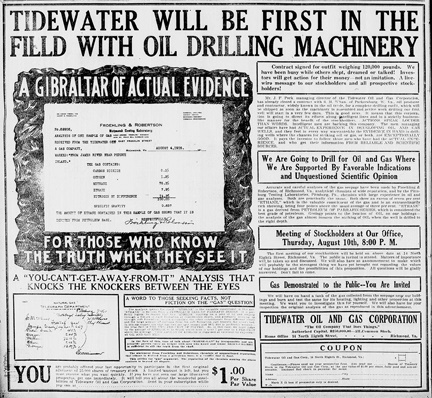
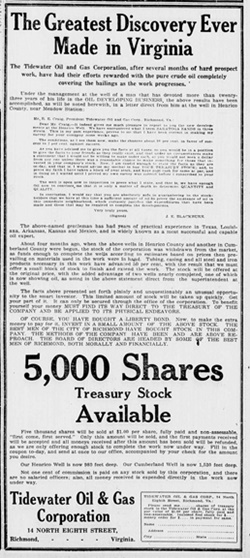
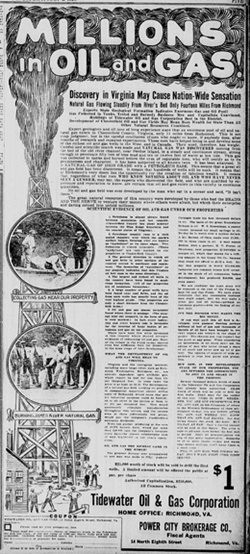
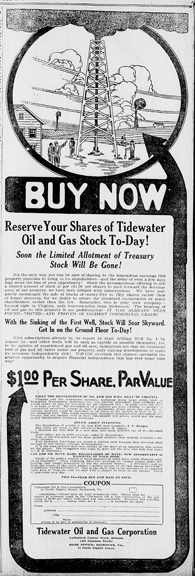
>Back to Top<
Now You Know
Solvers of last mystery object make...Four on a match
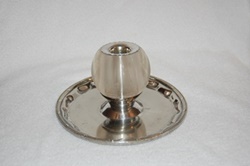
Congratulations and thanks go to Mary Jo and Haywood Wigglesworth, Kim Sicola and Paula Barlowe, all of whom correctly identified the "What Do You Know?" item from the last issue as a match holder and striker. Had one of them not solved the puzzle, we would have had the ominous condition of "Three on a match." The one pictured is an elegant antique receptable and was used in the early years at the Jefferson Hotel. Patrons would take a match from the glass cup, ignite it by scraping it along the ridges on the cup and then depositing the burned matchstick in the silver plated base.
It got us to thinking about matches, those ubiquitous little firestarters still offered by restaurants, hotels and all sorts of businesses despite modern smoking restrictions. Lighting a fire or a candle or charcoal grill is such a simple task now, but until the first half of the nineteenth century, the process by which fire was created was slow and laborious. It required flint and steel and tinder. One had to strike the hard flint against the steel to produce sparks onto the fluffy tinder and then blow on the tinder to encourage it to flame up. So rather than matches, our distant ancestors had metal fire strikers. Most were simple forged items, but some could be quite decorative.
Parisian Jean Chancel offered an alternative to this process when he invented the first modern, self-igniting match in 1805. The head of his match consisted of a mixture of potassium chlorate, sulfur, sugar, and rubber and was ignited by dipping its tip in a small bottle filled with sulfuric acid - a rather dangerous practice as well as expensive, so Chancel's matches never really became practical for common use.
Then in 1826, John Walker, a chemist in Stockton on Tees, discovered that a stick coated with chemicals burst into flame when he scraped it across his hearth at home. From this experience, he went on to invent the first friction match and sold his first "Friction Light" on 12 April 1827 from his pharmacy. Walker's first friction matches were made of cardboard, but he soon began to use wooden splints cut by hand. Later he packaged the matches in a cardboard box equipped with a piece of sandpaper for striking. He didn't patent his matches, and Samuel Jones of London took his idea and launched his own "Lucifers" in 1829, an exact copy of Walkers "Friction Lights".
Now, lighting fires was much easier, but the light was not without its dark side, specifically for those factory workers who produced the phosphorous matches. Prlonged exposure to white phosphorous vapor caused a condition called "Phossy jaw," formally known as phosphorous necrosis of the jaw. Workers in match factories developed abcesses in their mouths, leading to facial disfigurement and sometimes fatal brain damage. In addition, their gums developed an eerie greenish white "glow" in the dark.
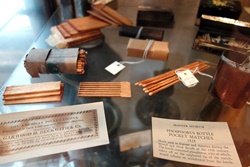
Lighting up. To the right is an image of phosphorous matches from the Joseph Allen Skinner Museum. Below left is a collection of antique fire strikes. Below right is a pack of Samuel Jone's Lucifers.
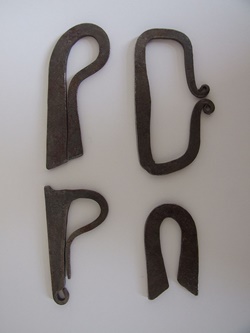
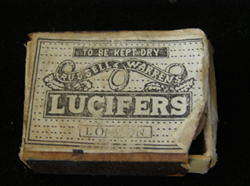
>Back to Top<
What Do You Know?
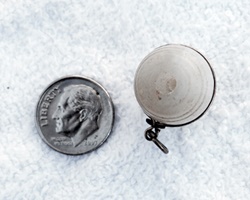
Three views of the same object are given above along with a dime to indicate its size. It's made of a glassy material encircled by a thin gold wire with a ring attached. The openings on each side are of slightly different sizes, with the smaller hole being a shallow opening and the larger hole opening into the hollow interior.
Do you know what it is?
Email your answers to jboheling@verizon.net.
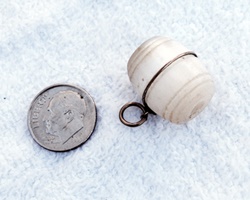
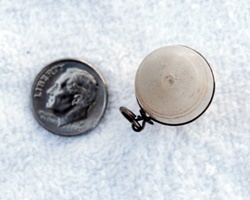
>Back to Top<
News 2020: Fourth Quarter
First Quarter | Second Quarter | Third Quarter
Home | Henrico | Maps | Genealogy | Preservation | Membership | Shopping | HCHS
|











